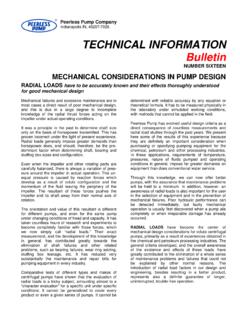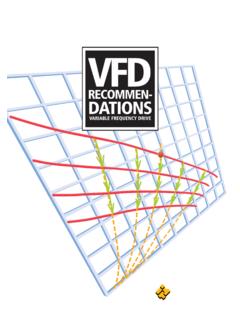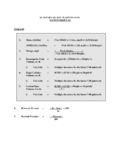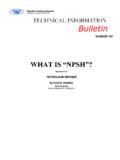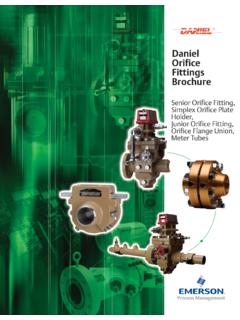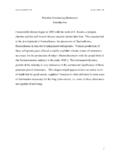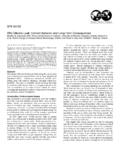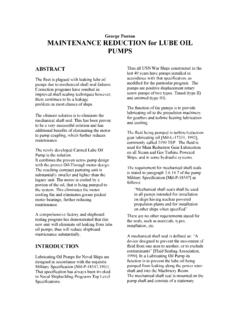Transcription of BULLETIN Number Twenty-Nine Selecting …
1 Peerless Pump CompanyIndianapolis, IN 46207-7026 TECHNICAL INFORMATIONBULLETINN umber twenty -NineSelecting mechanical SealsWhat Is a mechanical seal ?"What is a mechanical seal ?" A definition is bettergiven after the functions of a seal are container holding a liquid or a gas has a rotatableshaft extending through its housing. This housing isshown in Fig. 1. Fluid is to be kept from escapingwhere the shaft extends through the housing,especially as the shaft rotates. A ring, part1, with anO-ring, part 4, is sealed against the housing of thecontainer. It is called the mating ring. Another ring,part 2, with an O-ring, part 3, is mounted onto theshaft. It is called the primary sealing ring. Thecontacting faces of these rings arelapped flat, withinlight bands. Initial contact between the faces ismaintained by a spring, part 6, which pushes themtogether.
2 The spring reacts against a retainer, part 7,which is locked to the shaft, perhaps with set the shaft rotates theprimary sealing ring rotateswith it. To assure that the primary sealing ring doesnot slip, the retainer may have drive lugs (not shown)that engage corresponding slots of the primarysealing ring and provide positive drive. With themating ring stationary, there is relative motionbetween it and the primary sealing primary or "dynamic" sealing is done at the facesof the primary sealing ring and its mating ring. In aproperly designed seal they slide relative to eachother on a fluid film. The secondary or "static" sealingis done by O-rings or any other suitable gasketingFig. 1 mechanical end face sealarrangement. They are called secondary seals. Theremaining components are referred to as functional categories of a mechanical seal sealing ring and mating Secondary seals consisting of O-rings or othersuitable Hardware consisting mainly of spring mechanical seal can now be defined as a devicewhich prevents fluid leakage where a rotating shaftextends through a pressurized informationBefore design and material selections can be made atleast the following conditions under which the seal willperform must be to be the of the of the out, end play and vibration data are of ConstructionHardwareHardware usually presents only such problems as areencountered with normal machine elements.
3 In-formation regarding mechanical properties and chem-ical compatibilities can be found in handbooks. Mater-ials commonly used are steel, stainless steel, brass,Monel and Hastelloy materials should be checked carefullyforapplications involving corrosion and acting on a thin cross-sectioned wire weak-ens it more rapidly than if it were heavier. Thereforesprings in a corrosive media must be of the bestmaterial. For higher temperatures Inconel Xis anexcellent material which retains its controlled springforce at operating temperatures to 1800 :Elastomeric bellows sealA:O-ring sealB:Wedge sealSecondary Sealing ElementsAlthough considered static, meaning that there is norelative movement, the secondary seal at the primarysealing ring slides minutely as wear between the facesof the primary seals takes place. This movement isessential to keep them together.
4 Fluid pressure actingon the back surface of the primary sealing ring andspring force accomplish this. The secondary seal at theseat, however, is truly upon their requirements. Often a-rings,wedges, or other conventional packing arrangements,as shown in Fig. 2, are of the materials are of a resilient , neoprene, Viton rubber and other elastomersare common. This is advantageous; these materialshelp to dampen vibrations that could have a disturbinginfluence at the chemical applications require the compatibilityof TFE. Fig. 2(B) shows aTFEwedge used as asecondary seal . TFE has exceptional chemical of its outstanding properties is its low coefficient offriction, against itself. It is interesting to note thatthis is slightly better than ice on2C:V-ring sealE: Formed metal bellows sealF:Welded metal bellows sealFig. 2 Secondary sealsFig.
5 3 Compound carbon wedge secondary sealice. TFE has also been used successfully at very lowtemperatures in cryogenic applications. Case historiesfor liquid oxygen service at-310 F areon , TFE is one of the least radiation temperatures above 500 F the elastomers and TFElose their versatility. With the use of special material Vring assemblies as secondary seals, the limit can beincreased to650 F. Above this, other materials forsecondary seals are gaskets provide the answer for secondarysealing at the mating ring. For the secondary seal at theprimary sealing ring, which is not truly static but musthave some movement,straightforward gasketing cannotbe applied. In most of these extreme high temperaturecases metal bellows are used as the secondary bellows can compensate for the face wear byextending slightly. Bellows are of the formed or weldeddisk types,as shown in Figs.
6 2(E) and (F), and thematerial generally is stainless steel. Metal bellows sealsare also frequent choices for cryogenic applicationsalthough theTFEwedge has enjoyed interesting development along the lines of asecondary seal for high temperatures has been the socalled carbon wedge seal . Basically, the TFE wedge, asshown in Fig. 2(B), is replaced by a carbon carbon can extend the temperature limit to 12000F and even higher in a non-oxidizing atmosphere. Amore sophisticated version of this secondary seal typeis shown in Fig. Sealing ElementsThe primary sealing elements, the primary sealing ringand its mating ring, are really the heart of a mechanicalseal. The faces slide relative to each other, often at highvelocities and with considerable contact these conditions the phenomenon known aswear takes place. Although a common term, oftenaccepted quite casually, the mechanism and theory ofwear are very complex.
7 Barkan states, "Wear is asurface deterioration of contacting surfaces thatdestroys their operating relationship or causes rupture ifcarried far enough. The amount of wear depends on thenature of the contacting materials, the sliding,Viton is a registeredtrademark of DuPont Corporationrolling, or impact motion between them, the loadimposed, their lubrication, if any, and the chemicalaction of their lubrication and environment. Becausethese conditions introduce many types of wear, nostandardwear-resistancetestshavebeenre cognized. The tests performed in practice aredesigned to duplicate particular service conditionsas nearly as possible." We can appreciate thatproper material selection for the sliding parts is start-up there is a momentary dry-running period,then boundary lubrication and the eventual goal, fullhydrodynamic lubrication.
8 In this respect seal theoryresembles that of sliding bearings; it can bepostulated generally that a good bearing materialmay be a promising seal problem is that bearings usually are lubricatedwith oil; the "lubricant" for seals includes water, oil,gasoline, salt solutions, sea water, caustics andacids. Table 1 shows typical material combinationsthat are used as primary face detailed studyof Table 1 shows that everycategory contains carbon-graphite, or "mechanicalcarbon". A recommendation chart for material com-patibilities with various liquids shows that for wellover 500 liquids about 10 percent require referral tothe engineering department for consideration; of thelarge remainder 96 percent can use mechanicalcarbon. Of course it is not always the same carbon,for they are made in different grades each having itsown virtues.
9 Some are straight carbon-graphitecompositions; others areimpregnated with oils,synthetic resins, inorganic salts, polymers, and manyare metallized with copper, lead, babbit, antimony percent is a very impressive figure. Thequestion arises why carbon is such a desirablematerial. A simple answer is that years of testing andexperience have proved inertness, lubricity, heat dissipation andthermal shock resistance of the carbon compositionsprovide some insight to why they are desirable wearmaterials used so extensively inthe seal is customary to run dissimilar material com-binations (reflected in Table 1). From the viewpointof dynamic similarity it makes no difference whichpiece rotates or which stands still, so the carboncomponent could be either the primary sealing ringor its mating ring. Both pieces will wear. The generalassumption is that the harder piece wears less but,experience has shown that this is not always certain conditions, perhaps abrasive innature, the softer piece is more wear alone is no criterion for wear physical properties versus wearresistance, but no one complete solution has water applications at high pressures andtemperatures, such as boiler feed pumps, tungstencarbide running against carbon is a good versus carbon is an ideal combination usedfor many chemical environments.
10 Care must betaken not to use ceramic under temperaturefluctuations thatoccur suddenly, because of its lowthermal shock resistance. For some applications abase metal coated with ceramic is used. Thisstrengthens the ceramic which is relatively weak intension and also enhances its thermal shockresistance. The base metal itself should bechemically resistant to the fluids to which it issubjected so that diffusion through the thin coatingwill not attack it. Tungsten-carbide run against itselfand ceramic versus ceramic are also used, but havelimited usage and are restrictedto low pressuresand slow speeds. Carbon running against carbon isgaining acceptance in a wide range of the seal configurationVarious fundamental seal designs are available tothe seal user. These designs can be modifiedslightly to meet the dimensional requirements of theequipment and the environmental requirementsimposed by the liquid to be SealsOne of the most frequently encountered conditionsrequiring a slight modification in seal design an inside mechanical seal is called uponto seal high pressures, provision must be made toinsure that all of the pressure on the seal is nottrying to push the primary sealing ring to theatmospheric side of the stuffing 5 is a cross-section of a conventional insideunbalanced seal .



